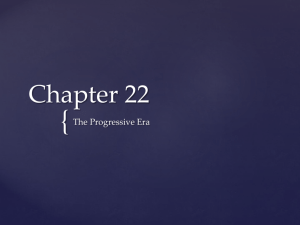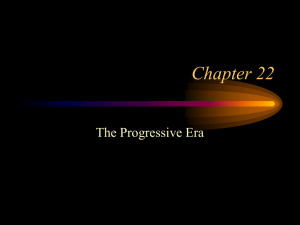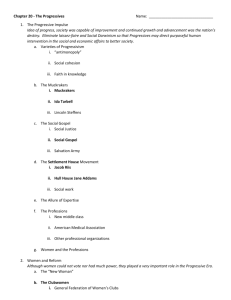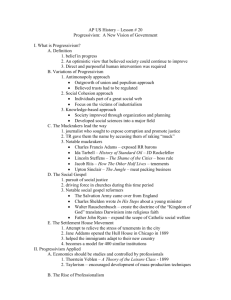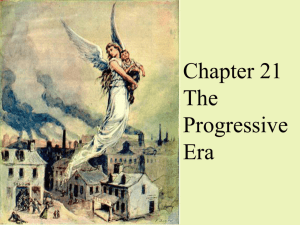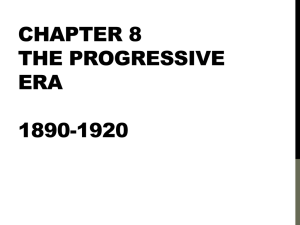The Progressive Era
advertisement
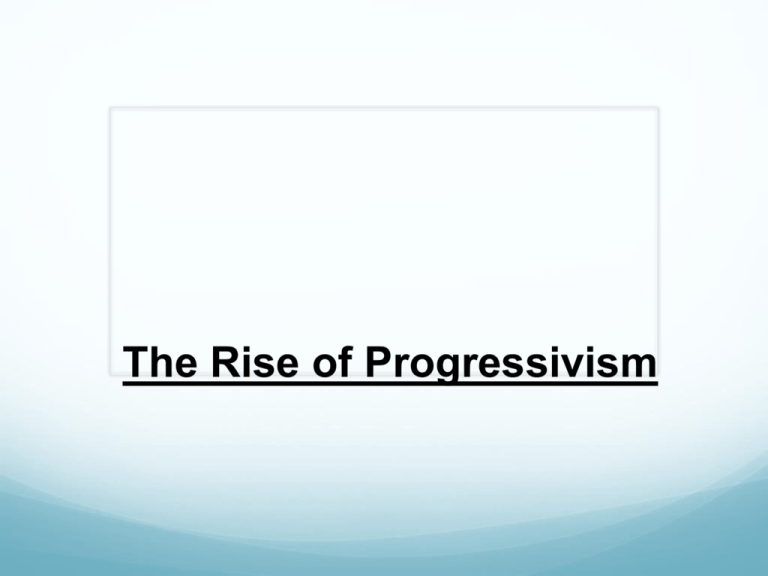
The Rise of Progressivism The Progressive Impulse the middle class feels those above are abusing the system and those below are becoming a Socialist threat – must have government become an “agency of human welfare” Varieties of Progressivism Progressives varied on how to intervene and reform popular idea of “antimonopoly” (fear of concentrated power, limit + disperse wealth, power) Social cohesion- welfare of single person dependent on welfare of society Faith in knowledge, principles of natural + social sciences, modernized government Muckrakers Muckrakers were crusading journalists who exposed social, economic, political injustices and corruption At first targeted trusts (particularly RR barons) Ida Tarbell’s study on Standard Oil. Later, attention toward government + political machines writings of Lincoln Steffens helped arouse sentiment for urban reforms The Social Gospel Muckrakers moralistic tone prompted outrage at social + economic injustice, led to rise of Protestant Social Gospel fusion of religion w/ reform Salvation Army was Christian social welfare organization; ministers left parish to serve in troubled cities Father John Ryan wrote of expanding scope of Catholic social welfare groups Religion w/ reform gave Progressivism moral component + commitment to redeem lives of even least favored citizens The Settlement House Movement Progressives believed environment influenced individual development. To help distressed required improving their conditions People believed crowded immigrant neighbors created distress Creation of settlement houses a response. College educated women often involved in settlement house movement Movement helped spawn profession of social work Jane Addams was a pioneer American settlement social worker, public philosopher, sociologist, author, and leader in women's suffrage and world peace. Addams was one of the most prominent reformers of the Progressive Era. She helped turn America to issues of concern to mothers, such as the needs of children, local public health, and world peace. She said that if women were to be responsible for cleaning up their communities and making them better places to live, they needed to be able to vote to do so effectively. Addams became a role model for middle-class women who volunteered to uplift their communities. In 1931 she became the first American woman to be awarded the Nobel Peace Prize and is recognized as the founder of the social work profession in the United States. Hull House Most famous was Jane Addams’ Hull House in Chicago Sought to help immigrant families adapt to language + culture Belief that middle-class had responsibility to share values w/ immigrants The Allure of Expertise Progressivism values application of scientific methods, knowledge, expertise- well-designed bureaucracy needed. Some proposed civilization where science could solve social + economic problems advocated in A Theory of The Leisure Class (1899) by Thorstein Veblen Rise of Social Sciences Rise of social sciences- scientific methods used to study society + its institutions. The Professions Late 19th century more people engaged in administrative + professional tasks (managers, scientists, teachers). This new middle class valued education, individual accomplishments. As demand for professionals increased so did their desire for reform to create organized professions Doctors saw creation of professional American Medical Association1901 strict standards for admissions, goverment passed laws requiring licensing; also rise of rigorous, scientific training and research Similar movements in other professions- lawyers formed bar associations w/ central examining boards businessmen formed Chamber of Commerce Women and the Professions Some women encountered obstacles in entering professions, but many from women’s colleges did enter “appropriate professions” settlement houses and social work, teaching, nursing (all had vague “domestic”/“helping” image) Women and Reform Role of Women and Women in Reform Causes The “New” Woman” “New woman” is a product of social and economic changes wage earning activity had moved out of house and into factory or office. children enrolled in school at earlier ages. technology (running water, electricity) made housework less of a burden. declining family size “Boston marriages”- women living w/ women Flappers Main Idea: Women have more time to do other things A Flapper’s Appeal to Parents, which appeared in the December 6, 1922, issue of Outlook Magazine, the writer and self-defined flapper Elllen Welles Page makes a plea to the older generation by describing not only how her outward appearance defines her flapperdom, but also the challenges that come with committing to a flapper lifestyle. “If one judge by appearances, I suppose I am a flapper. I am within the age limit. I wear bobbed hair, the badge of flapperhood. (And, oh, what a comfort it is!), I powder my nose. I wear fringed skirts and bright-colored sweaters, and scarfs, and waists with Peter Pan collars, and low-heeled “finale hopper” shoes. I adore to dance. I spend a large amount of time in automobiles. I attend hops, and proms, and ball-games, and crew races, and other affairs at men’s colleges. But none the less some of the most thoroughbred superflappers might blush to claim sistership or even remote relationship with such as I. I don’t use rouge, or lipstick, or pluck my eyebrows. I don’t smoke (I’ve tried it, and don’t like it), or drink, or tell “peppy stories.” I don’t pet. But then—there are many degrees of flapper. There is the semiflapper; the flapper; the superflapper. Each of these three main general divisions has its degrees of variation. I might possibly be placed somewhere in the middle of the first class.” She concludes.. “I want to beg all you parents, and grandparents, and friends, and teachers, and preachers—you who constitute the “older generation”—to overlook our shortcomings, at least for the present, and to appreciate our virtues. I wonder if it ever occurred to any of you that it required brains to become and remain a successful flapper? Indeed it does! It requires an enormous amount of cleverness and energy to keep going at the proper pace. It requires self- knowledge and self-analysis. We must know our capabilities and limitations. We must be constantly on the alert. Attainment of flapperhood is a big and serious undertaking!” From the 1922 “Eulogy on the Flapper,” one of the most well-known flappers, Zelda Fitzgerald, paints this picture: “The Flapper awoke from her lethargy of sub-deb-ism, bobbed her hair, put on her choicest pair of earrings and a great deal of audacity and rouge and went into the battle. She flirted because it was fun to flirt and wore a one-piece bathing suit because she had a good figure, she covered her face with powder and paint because she didn’t need it and she refused to be bored chiefly because she wasn’t boring. She was conscious that the things she did were the things she had always wanted to do. Mothers disapproved of their sons taking the Flapper to dances, to teas, to swim and most of all to heart. She had mostly masculine friends, but youth does not need friends—it needs only crowds.” The Clubwomen Late 19th/early 20th century rise of women’s clubs Network of associations that lead many reform movements GFWC • General Federation of Women’s Clubs (GFWC) • at first cultural, later focused on social betterment Public Space for Women • Clubs represented effort to extend women’s influence out of traditional role in home and create a public space for women. • Worked to lobby legislatures for regulation of children + women work conditions, food inspection, temperance. Women’s Trade Union League • Women’s Trade Union League rallied women to join unions, aid female labor. Woman’s Suffrage Challenge of Women’s Suffrage • Women’s suffrage movement at first advanced thru arguments that women deserved same “natural rights” as men, • opponents said society needed distinct female “sphere” • Suffragettes NAWSA • Early 20th century suffragists more organized • Anna Shaw + Carrie Chapman Catt formed National American Woman Suffrage Association (NAWSA) • Began to make “safer” arguments for suffrage in that voting would not ruin distinct sphere but allow women to bring special virtues to society’s problems and contribute to politics. • Some claimed could soothe male aggression (WWI) 19th Amendment 1910 Washington extended suffrage to women, more hesitant in East b/c of associations w/ ethnic conflict (Catholics) over temperance movement 1920 Nineteenth Amendment ratified guaranteeing female political rights; Women's Suffrage Map Equal Rights Amendment • others (including Alice Paul’s Woman’s Party) wanted to fight on for an Equal Rights Amendment to prohibit all discrimination based on sex Assault on the Parties Reforming Government Election Reform Direct Primary People choose candidates, not party conventions Referendum Allows legislatures to allow people to vote whether or not they like a law Initiative Allows people to propose and pass a law directly Recall Allows people to vote out an official in the middle of his term 17th Amendment 1913 allow direct election of Senators used to be appointed by State Legislatures Australian (secret) ballot Women’s Suffrage Support was largest in the western states Early Attacks Late 19th century populism and rise of Independent Republicans had attempted to break party lock on power- resulted in secret ballot. Attacking Party Rule Argued party rule could be dealt w/ by increasing power of people + ability to express will at polls, also put more power in nonpartisan, nonelected officials Municipal Reform Many progressives believed party rule most powerful in cities. Middle-class Progressives Muckrakers mobilized urban middle-class progressives against city bosses, special interests who benefited from machine organizations, immigrant laborers. New Forms of Governance Commission Plan- replaced mayor and council replaced w/ nonpartisan commission. First used in Galveston, TX in 1900, others followed City-Manager Plan- elected officials hired outside expert to run government Attempt remain above corruption of politics Successful reformer Cleveland Mayor Tom Johnson from conventional political structure controlled by progressives fought special interests Statehouse Progressivism Failure of some attacks on city boss rule led reformers to turn to state government for change progressives looked to circumvent incompetent state legislatures Initiative allowed reformers to submit legislation directly to voters in general election Referendum put actions of legislature directly to the people for approval Direct primary allowed people instead of bosses to choose candidates Recall gave voters right to remove elected official thru special election Famous state-level reformer was Gov Robert LaFollette in Wisconsin regulated RRs, utilities, workplace, graduated taxes on inherited wealth Parties and Interest Groups Reform did not destroy parties but led to decline in their influence seen by decreasing voter turnout. “Interest groups” emerged from professional organizations or labor to advance own demands directly to government, not thru party Sources of Progressive Reform Labor, The Machine, and Reform Samuel Gompers’s American Federation of Labor mostly uninvolved in reform at time but local unions played role in passing some state reform laws Parties tried to preserve interest by adapting some bosses allowed their machines to be vehicle of social reform e.g. Charles Murphy of Tammany Hall supported legislation for working conditions, child labor Triangle Shirtwaist Fire Triangle Shirtwaist Fire 1911 in NY killed many women workers b/c bosses had locked emergency exits. Commission delivered report calling for reform in labor conditions reform lead in legislature by Tammany Dems. Imposed regulation on factory owners and mechanisms for enforcement Western Progressives In Western states reformers targeted federal government b/c powerful as it never had been in East power over lands and resources, subsidies for RRs and water projects, issues transcended state borders. Weaker local + state governments led to weaker Western polit. parties governments passed progressive reforms more quickly African Americans and Reform African Americans faced large legal, social, economic, political obstacles in challenging their oppressed status and seeking reform many embraced Booker T Washington’s message of selfimprovement over long-term social change Tuskegee Institute W.E.B. Dubois 1900s new Niagara Movement led by WEB Du Bois (author of 1903 The Souls of Black Folk) called for immediate civil rights, professional education NAACP 1909 joined w/ supportive white progressives to form National Association for the Advancement of Colored People (NAACP) used federal lawsuits in pursuit of equal rights. In Guinn v. United States (1915) Supreme Court ruled grandfather clause illegal Buchanan v. Worley (1917) Court outlawed some segregation—NAACP established itself as leading black organization Crusades for Social Order and Reform Temperance Crusade Many progressives saw elimination of alcohol as way to restore societal order women saw alcohol as source of problems for families, employers saw it as roadblock to efficiency, political reformers saw saloon as Machine institution WCTU 1873 temperance supporters formed Women’s Christian Temperance Union (WCTU) led by Frances Willard, together w/ Anti-Saloon League called for abolition of saloons and prohibition of manufacture and sale of alcohol Eighteenth Amendment Opposition by immigrant and working-class voters; regardless, national effort and start of WWI moral fervor led to 1920 Eighteenth Amendment prohibition Immigration Restriction Reformers saw growing immigrant population as source of social problems some wanted to help assimilation, others to limit flow of new immigrants Early century pressure to slow immigration, heightened by growth of eugenics movement arguing human inequalities hereditary and immigration (especially of non-Anglo E. Eurs and Asians) resulting in growth of unfit peoples Publicist Madison Grant’s 1916 The Passing of the Great Race tied together eugenics + Nativism Congress’s Dillingham Report said new immigrants less able to assimilate than earlier groups, restrictions should be based on nationality Others supported restrictions as means to solve urban overcrowding, unemployment, strained social services, and unrest Challenging the Capitalist Order The Dream of Socialism Radical opposition to capitalist system strongest between 1900-1914 Some moderates favored nationalizing only major industries, use electoral politics; radicals including union Industrial Workers of the World (IWW) under William Haywood wanted abolition of “wage slave” system, favored use of general strike, supported unskilled workers (strong force in West) Eugene Debs Socialist Party under Eugene V. Debs grew during progressive era. Socialists wanted to change structure of economy, but disagreement as to extent and tactics Socialism’s Demise 1917 strike by IWW led to federal government crackdown on union b/c needed materials in mobilization for war IWW never fully recovered Socialist Party refusal to support war + growing antiradicalism led to decline of socialism as powerful political force in America Decentralization and Regulation Most progressives also saw major problem in great corporate centralization + consolidation, instead of nationalizing industries wanted federal govt to create balance between need for big business and need for competition Lawyer Louis Brandeis argued about “curse of bigness”, saw it as threat to efficiency and freedom, limited individual control of own destiny “Good Trusts” and “Bad Trusts” Others believed combinations sometimes helped efficiency, therefore government should distinguish between “good” and “bad” trusts to protect against abuses by “bad” concentrations. Supported by “nationalist” Herbert Croly in 1909 The Promise of American Life Movement growing for industry cooperation and self-regulation; others wanted active government role in regulation and planning economy
